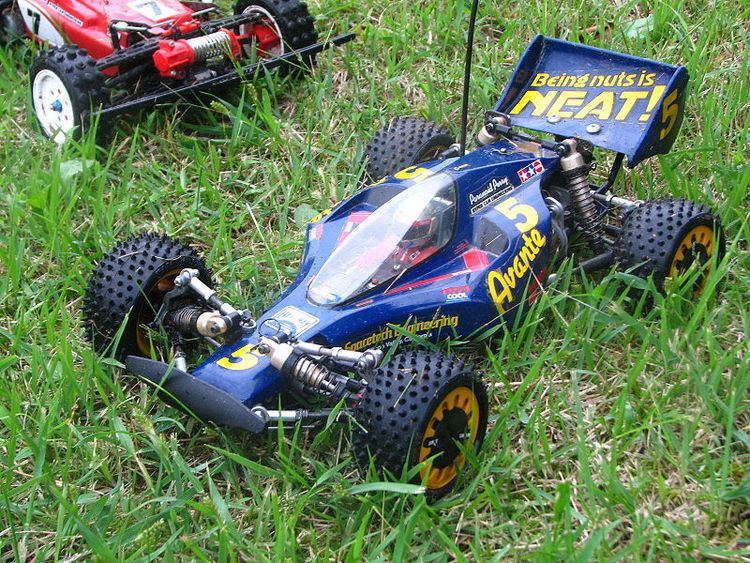Predecessor Tamiya Hotshot (ja) | Designer(s) Fumito Taki Successor Tamiya Egress (ja) | |
 | ||
Chassis Two-piece FRP composite "sandwich" | ||
The Tamiya Avante is an historically significant 1/10 scale four-wheel-drive electric offroad competition buggy released in 1988 as Tamiya's 72nd radio control kit under catalog number 58072.
Contents
Unveiled at the Nuremberg International Toy Fair that year, the Avante began as a need for a competition car after their past models became obsolete
History
Although Tamiya had significantly contributed to the market for 1/10-scale off-road starting with the Rough Rider in 1979, as their focus have been entry level and intermediates their aged Foxes and Hotshots became obsolete, as a result, the company fell significantly behind in the development of serious race cars such as those from manufacturers Schumacher, Kyosho, and Yokomo.
Starting with a new and somewhat radical design, Tamiya chose to create the Avante from aluminum and fiber-reinforced plastic composite as opposed to the ABS resin used in their previous offerings. It was also intended to be more tunable and adjustable than any other car on the market with its combination of a stiff composite chassis, oversized and tunable aluminum shocks and adjustable upper turnbuckles which allowed for changes in toe and caster.
Despite the seemingly winning combination of stiffness plus near-infinite adjustability, the Avante suffered more than its share of problems. Aluminum parts were easily broken, the front suspension had a tendency to bottom out on jumps and even the handling was subpar when compared to its competition. In a model with a retail price of US$300 ($608 in 2017), these faults were not easily overlooked by racers and sales suffered badly.
As a racecar, the car was designed to compete in its only race, the 1988 JMRCA All-Japan Off-Road 4WD Championship where it finished 7th, driven by Yoshiaki Sugiyama. By 1989, it was replaced by the Egress.
Overall, the Avante did advance the technology of four-wheel-drive offroad racing with its innovative use of exotic materials, ease of assembly and groundbreaking design features such as its motor mounted amidships and parallel to the driveshaft, its use of foam inserts in the tires to increase stiffness and ball front, rear, and center differentials, all standard fare on today's models. One feature of the Avante which is not common of today's models is the tool-less wheel nuts which required nothing but fingers to remove making pit stops and maintenance simple and quick. The Avante's basic design was used in future Tamiya offerings less the exotic materials.
It was credited to being the first model of its factory team, Tamiya Racing Factory (TRF), that help to yield five IFMAR touring car championship titles from 2002. Despite this success, it has yet to win an Off-Road Worlds title, achieving a 2nd place with Lee Martin in the 2WD class in 2013 before disbanding its off-road operations.
Today, the Avante is a highly sought-after collector's item, with new-in-box examples demanding more money than many other collectible Tamiya cars of the period.
The car is considered by its designer Fumito Taki, famous for introducing Tamiya into the radio-controlled car markets as well as a number of cars including the Sand Scorcher as his favorite designs.
Avante Mk. II
A competitive new sport/racing model, the Avante Mk. II, is based on Tamiya's DF-03 monocoque chassis topped with a Lexan body evoking the original car.
Avante 2011
In 2011, Tamiya re-released the Avante, and in 2012 released a special limited edition Black Special of the re-released Avante 2011.
